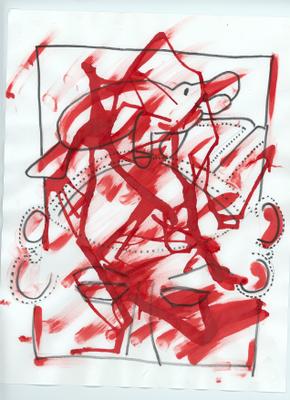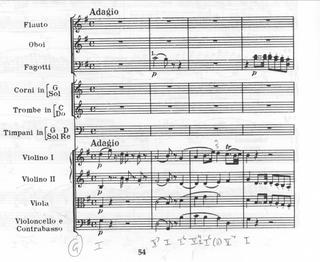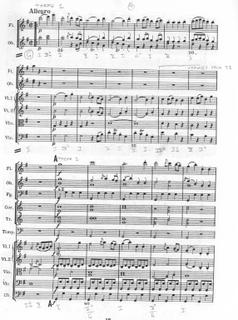A Sea-Cow, a Keyboard, a Score

I set out to be old-fashioned for this entry.
Compared to the venerable plow and graybeard arch, the arthritic steam engine and social-security-collecting cotton gin – compared especially to the hand-scrawled five-line staff, the alto clef, and D. C. al fine – sound recording is a precocious toddler. In its century of life, it has progressed from the ghostly crackle of wax cylinder and shellac to sterile 1s and 0s. O, Progress! Mother of happy Leisure and her sister Sloth!
What I’m driving at is that, today, almost any ‘classical’ music you want (provided it’s by a dead German guy) is available as a recording. Your index finger taps the PLAY> button and – insert your own snobby reference to Prospero – music comes out. The only effort for you, the listener, is to muster the concentration to actually listen. (Owing to the ubiquity of music in today’s landscape, listening properly is more difficult than it might seem.) How has this changed us?
(It’s great, actually, but I’m going to hone in on a negative aspect.)
The miracle of the PLAY> button has gradually left us, in certain particulars, numb. For instance: most classical radio stations treat Haydn symphonies (Harmonic Analysis Diary is doing a movement of a Haydn symphony today) as gentle wallpaper- suitably interesting to keep you awake during a commute, but comfortingly bland and ‘classy.’ In that sense, they’re interchangeable- here’s a slab of 18th century music, faintly dusted in wig-powder and stamped with a cute name like ‘Clock’ or ‘The Bear.’ To really hear these pieces and get excited by them is difficult, especially if you can go home and cue up Varese or the Flying Luttenbachers and get your visceral kicks out of that cacophony. Music as a construction – as a ‘piece’ rather than music as sound – has faded as a concept.

I had never heard Haydn’s Symphony No. 100. I am only mildly ashamed of this. Let’s face it: at this point in history, there are just too many masterpieces out there for anyone to have caught them all before the age of 40. Plus, the way I see it, this lacuna in my listening history gave me an opportunity to learn this famous piece the ‘old’ way.
Which is what I did- I learned it at the piano. Please, dear Reader, don’t have any delusions about my score-reading abilities. I’m fine at actually reading scores, mind you, but I don’t have anywhere near the piano technique to produce an acceptable keyboard realization on the fly. So, I did it as best I could- I learned all the tunes, learned their accompaniments, worked out the chords, and generally familiarized myself with the first movement. This made for an interesting relationship with the piece. It was like having a partially disassembled car strewn about the floor of the garage- you can crank the windows up and down within the amputated doors, run the engine, flick the lights on and off, admire the hubcaps. However, despite all your tinkering, you haven’t actually seen it hurtling down the road, and you certainly haven’t driven it yourself.
This, presumably, was what it must have been like for symphony enthusiasts before sound recording- there’s a powerful sense of anticipation and curiosity. You ‘know’ the piece, you can converse about it, but- has your imagination done justice to the excitement of that timpani entrance, or the sweetness of the high woodwind counterpoint?
Anyway, so I finally slung on my Sony MDR-7506s and popped in the Royal Concertbouw as conducted by Sir Colin Davis…
PLAY>
Jesus, what an amazing piece.
It makes you understand encores and repeat signs when you’ve learned a piece that way- you really want to hear it in every detail, to hear, in a sense, your own work pay off. You notice the little details of a sharpened accidental here or there (they gave you pause at the keyboard), the unusual way the woodwind phrases are articulated, the way the contrabass pizzicatos aren’t as loud as you’d expected. (Also, no matter how well you think you’re imagining it, an actual timpani entrance is ten times more exciting.)
Having said that, I’m loath to give the piece a conventional harmonic analysis. As I’ve moved through “Mostly Short Pieces”, it has often occurred to me that talking about the grand harmonic structure of a piece – particularly pieces from the ‘common practice’ period – doesn’t convey what makes you excited when you hear it. When you isolate themes and key areas, you neatly snip the grand ligne that is the spine music as an experience. When, in this movement, the final theme of the introduction begins at measure 93, only the most irritating, pedantic listener would actually think to himself – chin on fist as the pizzicatos buzz and the violins start their graceful little tune – “A-ha, that’s the ‘third’ theme- new, contrasting material to round off this introduction.” Therefore, I’m going to try talking about this piece the way Haydn might have ‘pitched’ it to an amateur music enthusiast at a dinner party- layman’s terms, imagery.
It’s a fantasy of war, armies, regalia- hence the name. Haydn himself apparently agreed to let Salomon advertise this symphony as ‘Military’. This is music from a different age of war: fifes, drums, cavalry charges, shining cuirasses.
The piece begins with an introductory Adagio so stately that it’s like a parade march in slow-motion, or perhaps a general’s slow inspection of his lines before the battle as he exhorts his men with both stern warnings and familiar encouragements. The themes of this movement, so steady (typically based on an initial upward leap), don’t recur, but the later melodic material is cut from similar cloth. In this sense, the slow introduction sets the military mood and builds to a grand dominant in expectation of the exciting Allegro.
If I may depart from layman’s terms: the most surprising harmonic trick of this introduction is a surprising unprepared modulation from G Major (the tonic) to E-flat Major– a major third below. Haydn never quite returns to the tonic during the introduction, either- touching instead on C Minor before the concluding D major chord.

This Allegro begins not with a crash of charging armies but a shrill, sprightly melody played in the flutes and oboes. This tune (the first theme) is the martial racket of fifes on the march- the winds play it once and pass it on to the violins. And then, chaos- the tune in the violins is spun out into motor rhythm figures that roll and roll in undulating waves while the trumpets and horns sound and the lower strings chuk-chuk-chuk like the clump of heavy boots. Then, just as the tumult dies down, the same fife tune strikes up in the flute and oboes again (in the dominant now), once again dissolving into bruit, though, amid the churn of strings. Then, the smoke clears- a new marching tune begins (technically the second theme, since the first theme was used twice)- this time in the strings. Gathering instruments and volume, it drives on to the end of the introduction.
Harmonically, this introduction moves from tonic (G) to the dominant (D). The surprise comes after the two empty bars between the introduction and the development- a big question mark for the listener. Then, not too loud, we’re abruptly in B-flat Major – a major third down from the D Major at the end of the introduction. Once again, Haydn’s shifted down by a major third without preparation.
The development is ‘the hellish roar of war’- uncertain modulations (usually by way of augmented 6th chords), intense fragmentation of the chipper marching tunes of the introduction, and a choice, weird chromatic effect. In this effect, Haydn seesaws repeatedly between a major chord and it’s neighbor a half-step above. This produces ostentatious parallel fourths- but, hey, war is hell, right? The orchestration grows increasingly raucous- trumpets blast and timpani roll, there are dynamic extremes like crescendi from piano to forte in the course of a single bar. When the tumult finally dies down, there’s an uncertain statement of fragments of the marching tune in a few keys – E Minor, C, G? – as though casting around to see what’s going to happen.
Feeling around with hesitant motor figures in the winds and oboes, we suddenly find ourselves at a reprise of the original fife tune. And then- the tune again, with full orchestra! In other words, we’ve arrived at the big recapitulation/conclusion. Staying – pretty much – in G Major, Haydn roars through all the march tunes again with bigger sonorities, spinning them out a little with playful extensions. (“Oh boy, we got ‘em on the run now!”) And then – one last surprise – there’s a thump as we drop down a major third into E-flat Major. This is the final unprepared modulation, and Haydn steers back into the tonic almost immediately. From there, it’s all stirring string swoops and trumpet calls to the end, the whole orchestra charging ahead at full gallop.
Next post: we bid farewell to Haydn with some keyboard variations.

1 Comments:
Ha I liked to hear that about MTT. I LOVE San Francisco with all my heart but I am annoyed by exactly the things you pointed out. The conductor-as-supreme communicator/powerful conjurer fetishism. It sort of goes on in a lot of cities but MTT is the biggest example these days. And yes-the picture of him on the Stravinsky cover is Howie Mandel-ish.
By the way great Haydn analyzationizining. Poor Haydn. If he wasn't always lumped together and overshaddowed by Amadeus Amadeus he would be better appreciated as the singular genius that he was.
Post a Comment
<< Home